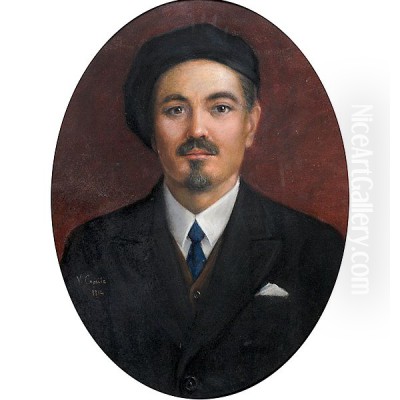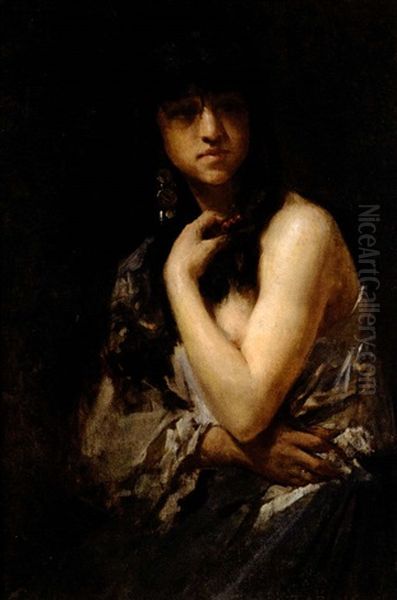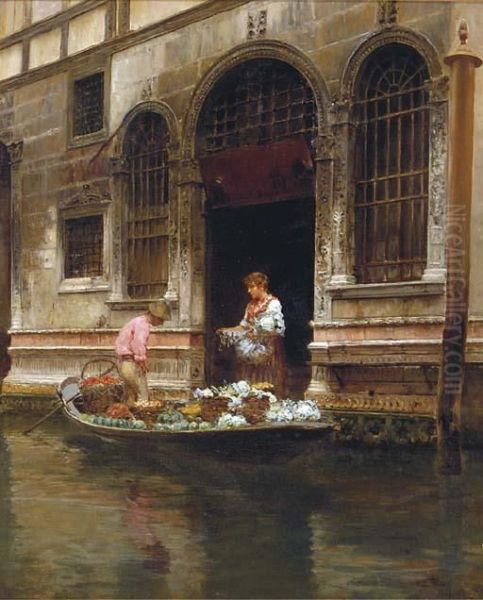
Vincenzo Caprile stands as a significant figure in the vibrant tapestry of late 19th and early 20th-century Italian art. Born in the bustling city of Naples on June 24, 1856, and passing away in his beloved hometown on June 23, 1936, Caprile dedicated his artistic life to capturing the light, landscapes, and daily life of Southern Italy. He emerged as a prominent exponent of Realism, particularly renowned for his evocative genre scenes and sun-drenched landscapes that continue to resonate with viewers today. His work offers a window into the Neapolitan world of his time, rendered with technical skill and genuine affection.
Formative Years in Naples
Caprile's artistic journey began in the city of his birth. Naples, during the latter half of the 19th century, was a major artistic center, pulsating with creative energy and diverse influences. He enrolled at the prestigious Naples Academy of Fine Arts (Accademia di Belle Arti di Napoli), a crucial institution that shaped generations of Southern Italian artists. Here, he had the invaluable opportunity to study under influential masters who would leave a lasting imprint on his development.
His training provided him with a solid foundation in academic principles, emphasizing drawing, composition, and the study of the human form. The Academy was a melting pot of ideas, where traditional approaches met emerging trends. This environment undoubtedly exposed Caprile to the ongoing debates about Realism, Romanticism, and the burgeoning interest in capturing contemporary life with authenticity.
The Influence of Teachers and Movements
Two key figures guided Caprile during his studies at the Academy: Domenico Morelli (1823-1901) and Gabriele Smargiassi (1798-1882). Morelli was a towering figure in Neapolitan painting, known for his historical and literary subjects rendered with dramatic flair and a rich, often dark, palette. While Morelli's subject matter differed from Caprile's later focus, his emphasis on emotional depth and painterly technique likely influenced the younger artist. Morelli himself was transitioning towards a more realistic approach in his later career, reflecting broader European trends.

Gabriele Smargiassi represented the established landscape tradition, known for his often idealized views. Studying under Smargiassi provided Caprile with essential skills in landscape composition and the rendering of natural elements. However, Caprile would soon move beyond the more conventional styles of his teachers, drawn towards a more direct and truthful depiction of the world around him.
Furthermore, Caprile became associated with the circle of artists connected to the School of Resina (Scuola di Resina). Though not a formal school, this group, strongly influenced by Filippo Palizzi (1818-1899), advocated for painting directly from nature (en plein air) and depicting everyday subjects with unvarnished truthfulness. Palizzi's emphasis on capturing the effects of light and atmosphere, often through studies of animals and rural scenes, resonated deeply with the burgeoning Realist movement in Naples and certainly impacted Caprile's approach.
Naples: A Crucible of Art
To fully appreciate Caprile's work, it's essential to understand the artistic milieu of Naples during his active years. The city was a hub for artists exploring Realism and its Italian variant, Verismo. This movement sought to portray ordinary life, often focusing on the struggles and experiences of the common people, with honesty and objectivity. Caprile was part of a generation that turned away from purely historical or mythological themes to embrace the contemporary world.
He worked alongside and was aware of numerous talented contemporaries who contributed to Naples' artistic renown. Figures like Antonio Mancini (1852-1930), known for his incredibly textured and psychologically intense portraits, pushed the boundaries of painterly technique. Francesco Paolo Michetti (1851-1929), though often associated with the Abruzzo region, shared a similar commitment to Verismo, capturing rural life with vibrant energy.
Other notable Neapolitan artists of the era included Edoardo Dalbono (1841-1915), celebrated for his luminous marine paintings and historical scenes of Naples, and Giuseppe De Nittis (1846-1884), who achieved international fame in Paris but retained his Neapolitan roots, known for his elegant depictions of modern life, often with Impressionistic touches. The sculptor Vincenzo Gemito (1852-1929) also contributed to this Realist environment with his incredibly lifelike busts and figures of Neapolitan street characters. Gioacchino Toma (1836-1891) offered more intimate, often melancholic, genre scenes. This rich context of artistic exploration provided a stimulating backdrop for Caprile's own development.
Caprile's Artistic Vision: Light and Realism

Vincenzo Caprile's signature style is firmly rooted in Realism, but it is a Realism infused with a distinct sensitivity to light and atmosphere. He possessed a remarkable ability to capture the brilliant Mediterranean sunlight as it illuminated landscapes, defined forms, and cast deep shadows. His paintings often feel immediate and alive, conveying the warmth and vibrancy of Southern Italy.
His brushwork, while capable of fine detail, often retained a certain vivacity and spontaneity, contributing to the freshness of his scenes. He wasn't merely documenting reality; he was interpreting it through a painterly lens, emphasizing the interplay of color and light. His palette was typically harmonious, utilizing warm earth tones alongside brilliant blues and greens to depict the sea, sky, and lush vegetation of the region. He excelled at rendering textures – the rough surface of stone walls, the shimmer of water, the fabric of clothing – adding to the tactile quality of his work.
Landscapes of Sun and Sea
Caprile is perhaps best known for his stunning landscapes, particularly those depicting the Bay of Naples and the Amalfi Coast. He was captivated by the dramatic coastal scenery, the picturesque towns clinging to hillsides, and the ever-present Vesuvius looming in the background. He painted these scenes repeatedly, exploring different times of day and weather conditions, always seeking to capture their unique essence.
His views of Positano, Capri, Sorrento, and Naples itself are celebrated for their atmospheric depth and luminous quality. He masterfully depicted the dazzling reflection of sunlight on the water, the hazy distance on a warm day, or the clear, crisp air after a storm. Works like View of Positano or Landscape with Houses exemplify his ability to combine topographical accuracy with a poetic sensibility. He didn't just paint a place; he conveyed the feeling of being there. His landscapes often include small figures, integrating human presence naturally within the grander scale of nature.
Scenes of Everyday Life
Alongside his landscapes, Caprile excelled in genre painting, depicting the daily activities and characteristic figures of Neapolitan life. He painted market scenes bustling with activity, fishermen mending nets or returning with their catch, women engaged in domestic tasks, and portraits of local people ('popolani'). These works demonstrate his keen observation skills and his empathy for his subjects.
Paintings such as Market Scene, Mandolin Girl, or Gitana showcase his ability to capture character and narrative within a single frame. He rendered the details of clothing, tools, and settings with care, providing valuable visual documentation of the period's customs and social environment. Unlike some Verismo painters who focused solely on hardship, Caprile often imbued his genre scenes with a sense of warmth and vitality, celebrating the resilience and spirit of the Neapolitan people. His portraits, like Portrait of a Boy or Girl with Shawl, are often intimate and direct, capturing the individuality of the sitter.
The Positano Connection
The town of Positano on the Amalfi Coast held a special significance for Caprile. He spent considerable time living and working there, and it became one of his most frequently depicted subjects. The dramatic cliffs, colourful houses cascading down to the sea, and the unique light of Positano provided endless inspiration. His paintings played a role in popularizing the town as an idyllic destination for artists and travellers.
Sources suggest he also taught art while in Positano, sharing his knowledge and passion with others drawn to the beauty of the region. This connection highlights his integration into the local community and his role not just as an observer but as an active participant in the cultural life of the places he painted. His depictions of Positano remain iconic representations of this beloved coastal town.
Exhibition and Acclaim
Throughout his career, Vincenzo Caprile actively participated in major national and international art exhibitions, showcasing his work to a wider audience. His paintings were well-received by critics and the public alike, appreciated for their technical skill, appealing subject matter, and authentic portrayal of Italian life. His success at these exhibitions helped solidify his reputation as a leading figure in the Neapolitan school.
His works entered important private and public collections. Galleries such as the Guglielmo Gallery in Milan and the Santa Antonina Gallery in Genoa are noted as holding his paintings. Today, his works continue to be sought after by collectors, appearing regularly at auctions. Pieces like Gitana, estimated at €12,000-€15,000, and Uomo con ombrello (€2,500-€3,500) in past sales, attest to the enduring market interest and recognition of his artistic merit. This commercial success reflects the broad appeal of his accessible and beautifully rendered scenes.
Peers and Artistic Circles
Caprile was an active member of the Neapolitan artistic community. His training under Morelli and Smargiassi, and his connection to the Palizzi-influenced School of Resina, placed him firmly within the mainstream of local artistic developments. He maintained connections with fellow artists, including figures like Luca Postiglione (1876-1936), Pietro Scoppetta (1863-1920), and Vincenzo Volpe (1855-1929), who were also prominent painters in Naples, often exploring similar themes of landscape and genre.
While part of this vibrant circle, specific details about collaborative projects are not widely documented. Artistic exchange and mutual influence were certainly part of the environment, but Caprile largely forged his own distinct path within the broader Realist movement. It is important to note that while some popular accounts might link travelling intellectuals or artists like Virginia Woolf or Oscar Wilde to the general artistic milieu of Italy at the time, there is no specific historical evidence confirming direct, meaningful contact or collaboration between Caprile and these particular literary figures. His primary context remained the rich artistic scene of Naples and Southern Italy.
Teaching and Legacy
While sources mention Caprile teaching, particularly during his time in Positano, there is no record of him having mentored students who later achieved significant fame in their own right. His primary contribution lies in his own prolific output and his consistent dedication to his artistic vision.
Vincenzo Caprile's legacy endures through his paintings. He remains a beloved figure in Italian art history, celebrated for his ability to capture the unique light, atmosphere, and human spirit of Naples and the Amalfi Coast. He was a master technician, skilled in composition, color, and the rendering of light, but his work transcends mere technical prowess. It offers a heartfelt and enduring vision of a specific time and place, preserving the beauty and vitality of Southern Italian life for future generations. His paintings continue to enchant viewers with their luminosity, authenticity, and affectionate portrayal of the world he knew so well.
Conclusion
Vincenzo Caprile was more than just a skilled painter; he was a visual poet of Naples and its surrounding beauty. Through his dedication to Realism, tempered with a profound sensitivity to light and atmosphere, he created a body of work that celebrates the landscapes and people of Southern Italy. From the sun-drenched vistas of the Amalfi Coast to the intimate scenes of daily Neapolitan life, his paintings offer a window into a bygone era, rendered with technical brilliance and genuine warmth. As a key figure in the Neapolitan school of painting, his art remains a testament to the enduring power of observation and the ability of painting to capture the soul of a place.